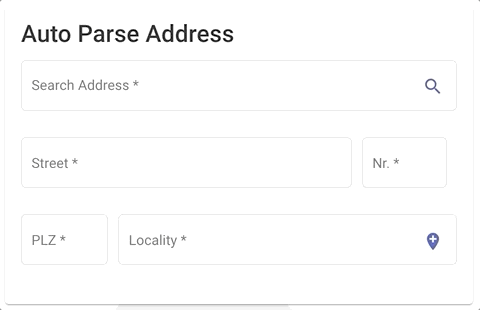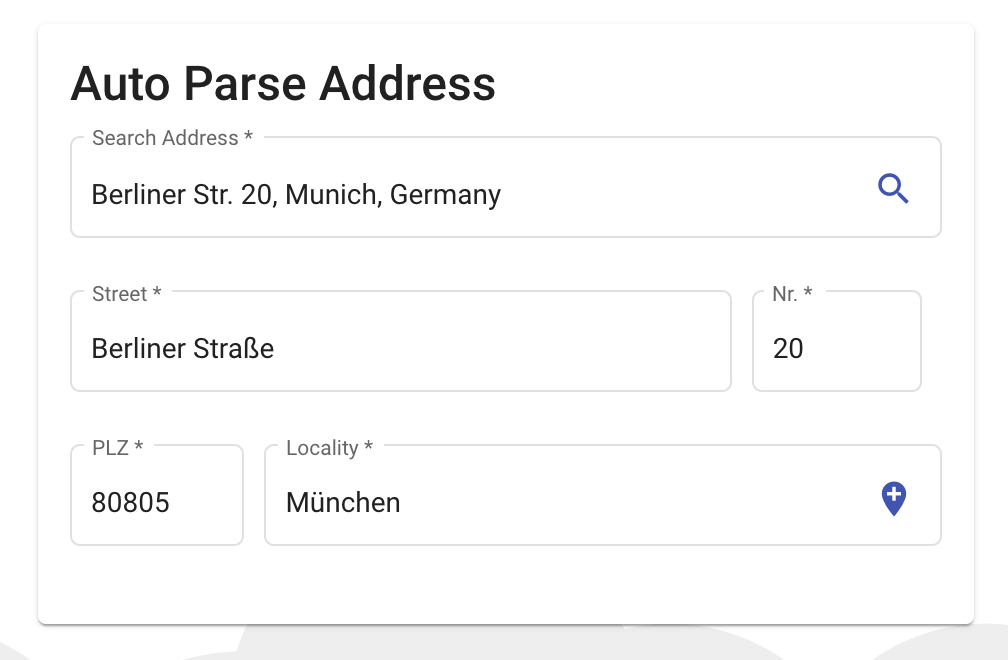@angular-material-extensions/google-maps-autocomplete - Autocomplete input component for google-maps built with angular material design
Stating with v1.3.0, you can now use this library without material2's dependency! To enable this goolgle maps
autocomplate api as feature, you can just add matGoogleMapsAutocomplete
to any html input element!
Do you have any question or suggestion ? Please do not hesitate to contact us! Alternatively, provide a PR | open an appropriate issue here
If did you like this project, support angular-material-extensions by starring ⭐ and sharing it 📢
- Demo
- Dependencies
- Peer Dependencies
- Additional Requirements - material (Include a theme)
- Installation
- Usage
- Documentation
- Run Demo App Locally
- Development
- Other Angular Libraries
- Support
- License
View all the directives and components in action at https://angular-material-extensions.github.io/google-maps-autocomplete
- Angular (requires Angular 2 or higher | we are using already V11 ;)
for the directive as standalone you just need to install the agm core module
npm i @agm/core optional
npm i -D @types/googlemaps If Angular Material Design is not setup, just
run ng add @angular/material learn more
Now add the library via the angular schematics and everything will be setup for you
ng add @angular-material-extensions/google-maps-autocompleteNow install @angular-material-extensions/google-maps-autocomplete via:
npm install --save @angular-material-extensions/google-maps-autocompletefor the ui input component, please consider installing the following packages
- angular animations v11.x
- angular forms v11.x
- angular material v11.x
- angular cdk v11.x
- agm - angular google maps v3.0.0-beta.0
npm i @angular/cdk @angular/material @angular/animations @angular/forms Note:If you are using
SystemJS, you should adjust your configuration to point to the UMD bundle. In your systemjs config file,mapneeds to tell the System loader where to look for@angular-material-extensions/google-maps-autocomplete:
{
'@angular-material-extensions/google-maps-autocomplete';
:
'node_modules/@angular-material-extensions/google-maps-autocomplete/bundles/google-maps-autocomplete.umd.js',
}Once installed you need to import the main module:
import {MatGoogleMapsAutocompleteModule} from '@angular-material-extensions/google-maps-autocomplete';The only remaining part is to list the imported module in your application module. The exact method will be slightly
different for the root (top-level) module for which you should end up with the code similar to (
notice MatGoogleMapsAutocompleteModule.forRoot()):
import {AgmCoreModule} from '@agm/core';
import {MatGoogleMapsAutocompleteModule} from '@angular-material-extensions/google-maps-autocomplete';
@NgModule({
declarations: [AppComponent, ...],
imports: [
// important !!!
AgmCoreModule.forRoot({
apiKey: 'YOUR_KEY',
libraries: ['places']
}),
MatGoogleMapsAutocompleteModule, ...],
bootstrap: [AppComponent]
})
export class AppModule {
}Other modules in your application can simply import MatGoogleMapsAutocompleteModule:
import {MatGoogleMapsAutocompleteModule} from '@angular-material-extensions/google-maps-autocomplete';
@NgModule({
declarations: [OtherComponent, ...],
imports: [
MatGoogleMapsAutocompleteModule, ...],
})
export class OtherModule {
}add matGoogleMapsAutocomplete to your target html input element to enable the google maps autocomplete api as feature
<mat-form-field>
<mat-label>Address << using the directive >></mat-label>
<input matInput
matGoogleMapsAutocomplete
[country]="de"
(onAutocompleteSelected)="onAutocompleteSelected($event)"
(onLocationSelected)="onLocationSelected($event)">
</mat-form-field>add mat-google-maps-auto-complete element to your template
<mat-google-maps-autocomplete [appearance]="appearance.OUTLINE"
(onAutocompleteSelected)="onAutocompleteSelected($event)"
(onLocationSelected)="onLocationSelected($event)">
</mat-google-maps-autocomplete>A customized mat-google-maps-autocomplete
<mat-google-maps-autocomplete country="us"
type="address"
(onAutocompleteSelected)="onAutocompleteSelected($event)"
(onLocationSelected)="onLocationSelected($event)">
</mat-google-maps-autocomplete>combine the result of the mat-google-maps-autocomplete with a google map instance
via @agm
<div class="container" fxLayout="column" fxLayoutAlign="center">
<div fxFlex>
<agm-map [latitude]="latitude" [longitude]="longitude" [scrollwheel]="false" [zoom]="zoom">
<agm-marker [latitude]="latitude" [longitude]="longitude"></agm-marker>
</agm-map>
</div>
<div fxFlex fxFlexAlign="center"
class="autocomplete-container"
[ngStyle.xs]="{'min-width.%': 100}"
[ngStyle.sm]="{'width.%': 70}">
<mat-google-maps-autocomplete (onAutocompleteSelected)="onAutocompleteSelected($event)"
(onLocationSelected)="onLocationSelected($event)"
(onGermanAddressMapped)="onGermanAddressMapped($event)">
</mat-google-maps-autocomplete>
</div>
</div>in your component, the code will be similar to -->
import {Component, OnInit, ViewEncapsulation} from '@angular/core';
import {Title} from '@angular/platform-browser';
import {Location, Appearance, GermanAddress} from '@angular-material-extensions/google-maps-autocomplete';
import PlaceResult = google.maps.places.PlaceResult;
@Component({
selector: 'app-home',
templateUrl: './home.component.html',
styleUrls: ['./home.component.scss'],
encapsulation: ViewEncapsulation.None,
})
export class HomeComponent implements OnInit {
public appearance = Appearance;
public zoom: number;
public latitude: number;
public longitude: number;
public selectedAddress: PlaceResult;
constructor(private titleService: Title) {
}
ngOnInit() {
this.titleService.setTitle('Home | @angular-material-extensions/google-maps-autocomplete');
this.zoom = 10;
this.latitude = 52.520008;
this.longitude = 13.404954;
this.setCurrentPosition();
}
private setCurrentPosition() {
if ('geolocation' in navigator) {
navigator.geolocation.getCurrentPosition((position) => {
this.latitude = position.coords.latitude;
this.longitude = position.coords.longitude;
this.zoom = 12;
});
}
}
onAutocompleteSelected(result: PlaceResult) {
console.log('onAutocompleteSelected: ', result);
}
onLocationSelected(location: Location) {
console.log('onLocationSelected: ', location);
this.latitude = location.latitude;
this.longitude = location.longitude;
}
onGermanAddressMapped($event: GermanAddress) {
console.log('onGermanAddressMapped', $event);
}
}<form [formGroup]="addressFormGroup">
<mat-search-google-maps-autocomplete formControlName="address">
</mat-search-google-maps-autocomplete>
// OR
<mat-google-maps-autocomplete formControlName="address">
</mat-google-maps-autocomplete>
</form>import {Component, OnInit} from '@angular/core';
import {FormControl, FormGroup} from '@angular/forms';
@Component({
selector: 'app-root',
templateUrl: './app.component.html',
styleUrls: ['./app.component.scss']
})
export class AppComponent implements OnInit {
addressFormGroup: FormGroup;
ngOnInit(): void {
this.addressFormGroup = new FormGroup({
address: new FormControl(),
});
this.addressFormGroup.get('address').valueChanges.subscribe(value => console.log('value changed', value))
}
}API - for more info please visit the official documentation Maps JavaScript API
| option | bind | type | default | description |
|---|---|---|---|---|
| value | Input() |
PlaceResult ; | - | |
| address | Input() |
PlaceResult | string; | - |
| country | Input() |
string | string[]; | - |
| placeIdOnly | Input() |
boolean | - | can be used to instruct the Autocomplete widget to retrieve only Place IDs. On calling getPlace() on the Autocomplete object, the PlaceResult made available will only have the place id, types and name properties set. You can use the returned place ID with calls to the Places, Geocoding, Directions or Distance Matrix services. |
| strictBounds | Input() |
boolean | - | is a boolean specifying whether the API must return only those places that are strictly within the region defined by the given bounds. The API does not return results outside this region even if they match the user input. |
| types | Input() |
string[] | - | An array of types specifies an explicit type or a type collection, as listed in the supported types below. If nothing is specified, all types are returned. In general only a single type is allowed. The exception is that you can safely mix the geocode and establishment types, but note that this will have the same effect as specifying no types. Supported types are listed below. |
| type | Input() |
string | - | |
| autoCompleteOptions | Input() |
AutocompleteOptions | - | all above inputs in one object! The passed data to this object will be merged with the input if they exists |
| onChange | Output() |
PlaceResult | string | null |
| onAutocompleteSelected | Output() |
PlaceResult | - | the event will be fired when a place has been selected via the google maps autocomplete component |
| onGermanAddressMapped | Output() |
GermanAddress | - | the event will be fired when a place has been selected and mapped to the german address interface |
| onLocationSelected | Output() |
Location | - | the event will be fired when a place has been selected via the google maps autocomplete component |
| type | description |
|---|---|
| geocode | instructs the Places service to return only geocoding results, rather than business results. |
| address | instructs the Places service to return only geocoding results with a precise address. |
| establishment | instructs the Places service to return only business results. |
| regions | instructs the Places service to return any result matching the following types: locality, sublocality, postal_code, country, administrative_area1, administrative_area2 |
| cities | instructs the Places service to return results that match either locality or administrative_area3. |
everything included in matGoogleMapsAutocomplete + the following
| option | bind | type | default | description |
|---|---|---|---|---|
| addressLabelText | Input() |
string; | Address using the component | self explanatory |
| placeholderText | Input() |
string; | Please enter the address | self explanatory |
| requiredErrorText | Input() |
string; | The address is required | self explanatory |
| invalidErrorText | Input() |
string; | The address is not valid | self explanatory |
| appearance | Input() |
Appearance | string; | Appearance.STANDARD |
| option | bind | type | default | description |
|---|---|---|---|---|
| searchBarAppearance | Input() |
Appearance | string; | Appearance.STANDARD |
| appearance | Input() |
Appearance | string; | Appearance.STANDARD |
| searchAddressLabel | Input() |
string; | Search Address |
input label |
| streetNameLabel | Input() |
string; | Street |
input label |
| streetNumberLabel | Input() |
string; | Nr. |
input label |
| postalCodeLabel | Input() |
string; | PLZ |
input label |
| vicinityLabel | Input() |
string; | Locality |
input label |
| localityLabel | Input() |
string; | Locality |
input label |
| showVicinity | Input() |
boolean; | false |
input label - whether to display the vecinity |
| readonly | Input() |
boolean; | false |
readonly input |
| disableSearch | Input() |
boolean; | false |
disabled users to search a place |
| value | Input() |
GermanAddress; |
- | the initial value of the component |
| country | Input() |
string | string[]; | - |
| placeIdOnly | Input() |
boolean | - | can be used to instruct the Autocomplete widget to retrieve only Place IDs. On calling getPlace() on the Autocomplete object, the PlaceResult made available will only have the place id, types and name properties set. You can use the returned place ID with calls to the Places, Geocoding, Directions or Distance Matrix services. |
| strictBounds | Input() |
boolean | - | is a boolean specifying whether the API must return only those places that are strictly within the region defined by the given bounds. The API does not return results outside this region even if they match the user input. |
| types | Input() |
string[] | - | An array of types specifies an explicit type or a type collection, as listed in the supported types below. If nothing is specified, all types are returned. In general only a single type is allowed. The exception is that you can safely mix the geocode and establishment types, but note that this will have the same effect as specifying no types. Supported types are listed below. |
| type | Input() |
string | - | |
| onGermanAddressMapped | Output() |
EventEmitter | string; | Appearance.STANDARD |
<mat-card>
<mat-card-title>Auto Parse Address</mat-card-title>
<mat-card-content>
<!-- ####### here we go !! ######-->
<mat-search-google-maps-autocomplete appearance="outline"
country="de"
(onGermanAddressMapped)="onGermanAddressMapped($event)">
>
</mat-search-google-maps-autocomplete>
</mat-card-content>
</mat-card>import {Appearance, GermanAddress, Location} from '@angular-material-extensions/google-maps-autocomplete';
onGermanAddressMapped($event;
:
GermanAddress;
)
{
console.log('onGermanAddressMapped', $event);
}Please checkout the full documentation here or follow the official tutorial
- clone this repo by running
$ git clone https://github.com/angular-material-extensions/google-maps-autocomplete.git- link the @angular-material-extensions/google-maps-autocomplete package
$ gulp link- navigate to the demo app directory, install the dependencies and serve the app
$ cd demo && npm i && npm start- the app is now hosted by
http://localhost:4200/
- clone this repo
- Install the dependencies by running
npm i - go to lib directory under
projects/angular-material-extensions/google-maps-autocomplete - build the library
npm run build
- ngx-auth-firebaseui
- ngx-linkifyjs
- ngx-mailto
- @firebaseui/ng-bootstrap
- @angular-material-extensions/pages
- @angular-material-extensions/link-preview
- @angular-material-extensions/password-strength
- @angular-material-extensions/select-country
- @angular-material-extensions/select-icon
- @angular-material-extensions/fab-menu
- @angular-material-extensions/faq
- @angular-material-extensions/contacts
- Drop an email to: Anthony Nahas
- or open an appropriate issue
- let us chat on Gitter
Built by and for developers ❤️ we will help you 👊
Copyright (c) 2019-2020 Anthony Nahas. Licensed under the MIT License ( MIT)








